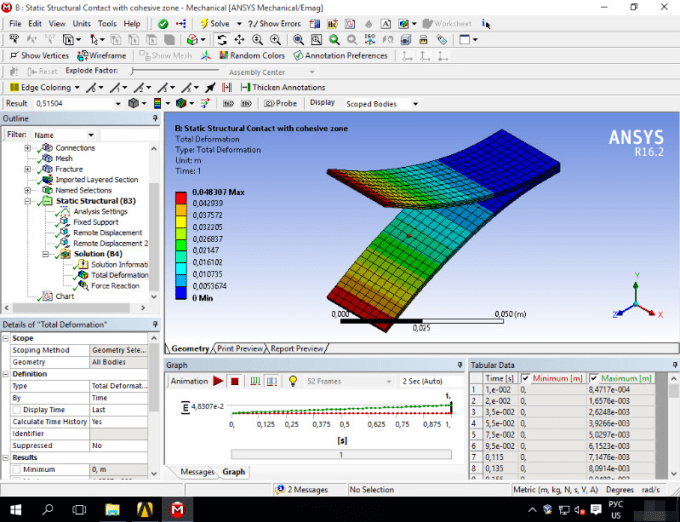
These are many times the most common type of elements being used in FEA. Extremely simple element type which provides rapid solutions when it’s limitations are acceptable.ĢD Elements can be used to analyze sheet metal and similar structures.Any other applications that aren’t in pure tension, compression, or bending.
 When local stresses may control such as bolt tear out, block shear, etc…. In a 3D analysis, each node has 6 DOF (x, y, z, x-rot, y-rot, z-rot). In a 2D analysis, each node has 3 DOF (x, y, rotation). The number of degrees of freedom (DOF) at each node depends upon the type of analysis being used. Types of FEA Elements 1D or Line or Beam ElementsġD Line Elements such as beams have the capability of simulating tension, compression and bending. Having a linear stress plot and therefore a constant strain and stress over an element can cause significant issues with the accuracy of FEA results as will be seen later. Stain is a derivative of stress, which means that if you have a linear stress plot, the strain will be constant. Strain is a unitless value which can be directly related to Stress using stress-strain curves from material properties. Strain = Change in Length / Initial Total Length In order to calculate stress you need to first derive strain from the deformation solution and then can use the stress strain curve to convert the strain to stress. The General Stiffness Method calculates the displacement at each node and then uses interpolation over the elements to determine the solution. The General Stiffness Method is a modified form of the Slope-Deflection Method. General Stiffness Method – aka Displacement Method
When local stresses may control such as bolt tear out, block shear, etc…. In a 3D analysis, each node has 6 DOF (x, y, z, x-rot, y-rot, z-rot). In a 2D analysis, each node has 3 DOF (x, y, rotation). The number of degrees of freedom (DOF) at each node depends upon the type of analysis being used. Types of FEA Elements 1D or Line or Beam ElementsġD Line Elements such as beams have the capability of simulating tension, compression and bending. Having a linear stress plot and therefore a constant strain and stress over an element can cause significant issues with the accuracy of FEA results as will be seen later. Stain is a derivative of stress, which means that if you have a linear stress plot, the strain will be constant. Strain is a unitless value which can be directly related to Stress using stress-strain curves from material properties. Strain = Change in Length / Initial Total Length In order to calculate stress you need to first derive strain from the deformation solution and then can use the stress strain curve to convert the strain to stress. The General Stiffness Method calculates the displacement at each node and then uses interpolation over the elements to determine the solution. The General Stiffness Method is a modified form of the Slope-Deflection Method. General Stiffness Method – aka Displacement Method 2d model ansys 15 software#
General Stiffness Method – Method Used By Most FEA Software. Slope-Deflection Method – Hand Calculation Method. Flexibility Method – Hand Calculations and Occasional FEA. There multiple methods to solve statically indeterminate problems. In other words, statically indeterminate structures have more variables that you need to solve for than they have equations making finding a solution using the standard static method impossible. Most structures of interest today are statically indeterminate meaning they have more internal forces and reactions than there are static equilibrium equations. Adding a 3rd node in the center of an element is so effective at increasing accuracy that the majority of FEA software including ANSYS start with a 3 node beam (BEAM3) as their simplest element. This opens up the ability to use quadratic or higher order interpolation instead of linear interpolation. One of the best ways to increase the accuracy of a simulation is to use more nodes in an element. Adding More Nodes Per Element 3 Node Element 3-Node Quadratic Interpolation Element Most results are based on the square or cube of a variable meaning the results between nodes won’t change linearly, but instead quadratically. One issue with simply using smaller elements is that most physical phenomena aren’t estimated well by linear interpolation. However, points at which significant changes do occur over a short distance such as at corners or holes this is necessary to gain an accurate result. 
Where results are not changing significantly between nodal points this is unnecessary. The most straight forward way to improve accuracy is to make your elements smaller. Improving FEA Result Accuracy Reducing Element Size Half Size Elements 2-Node Half Size Elements Between nodes of a single element solutions are estimated through using interpolation. Nodes are points at which exact solutions are calculated. What are FEA Nodes & Elements? Simplest Element 2-Node Single ElementĮlements are made up of at least 2 nodes. This allows for engineers to gain insight and optimize design performance prior to investing in an expensive physical prototypes. Finite Element Analysis (FEA) uses a geometrical mesh made up of nodes and elements to simulate a wide range of physical interactions.






 0 kommentar(er)
0 kommentar(er)
